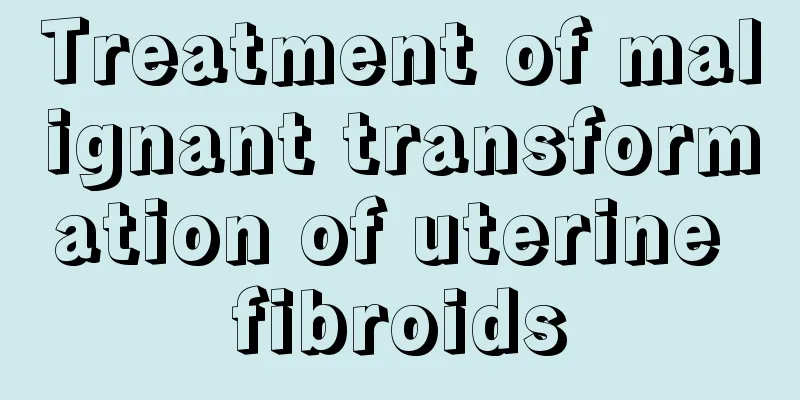Treatment of malignant transformation of uterine fibroids

|
Uterine fibroids actually have the possibility of becoming malignant. Therefore, once you find yourself affected by this disease or have similar symptoms, you should pay attention to a comprehensive examination. This will remind you to get symptomatic treatment and reduce the harm. 1. Expectant treatment. Generally, if the fibroids are smaller than 8 weeks of gestation, with no obvious symptoms, no complications and no fibroid degeneration, or if the uterus of a near-menopausal woman is smaller than 12 weeks of gestation, with normal menstruation and no compression symptoms, expectant management and temporary observation can be adopted. Adhere to re-examination every 3-6 months, that is, regular follow-up observation in clinical and imaging aspects. Generally, fibroids will gradually shrink after menopause. However, it should be noted that in a small number of patients after menopause, uterine fibroids do not shrink but increase in size, so follow-up should be strengthened. If the fibroids are found to be enlarged and growing rapidly during the follow-up period, if they are submucosal fibroids or suspected fibroid degeneration, or if they have obvious symptoms and anemia, surgical treatment should be considered. 2. Myomectomy. It is mainly suitable for patients under 45 years old, especially under 40 years old, who want to preserve their fertility. Myomectomy can be performed on subserosal, intramural, or even submucosal fibroids while preserving the uterus. Submucosal fibroids can be removed through hysteroscopic surgery. Hysteroscopic surgery causes less pain to patients, and recovery is faster after surgery. The surgery can even be performed on an outpatient basis. 3. Total hysterectomy. Older patients with uterine fibroids who have obvious symptoms and no desire to continue having children should undergo total hysterectomy. Patients around 50 years old can retain one or both normal ovaries to maintain their endocrine function. Total hysterectomy can be performed via video laparoscopy, vaginal surgery, or laparotomy. Laparoscopic or vaginal surgery causes little trauma to patients, has a quick recovery, leaves almost no scars, and requires a short hospital stay. It is the current trend in the development of gynecological surgery. |
<<: What should I do if my uterine fibroids are calcified?
>>: What are the symptoms of vaginitis? We must learn to make correct judgments in the future
Recommend
What causes pink vaginal discharge?
What is the reason why the secretion is light pin...
How much does it cost to have a baby?
Pregnancy is never just a matter for the pregnant...
What is the cause of a row of small bumps on the vulva?
Female friends have been troubled by various gyne...
Is the tenth day of menstruation the ovulation period?
For men and women who are preparing for pregnancy...
What to do if the follicles are uneven in size
Uneven follicle development size is also a common...
Can you wake up with a headache during sleep?
This is the 4625th article of Da Yi Xiao Hu Heada...
Is it okay to use toothpaste to wash the vulva?
Toothpaste is an indispensable daily necessity in...
What is the cause of endometrial tuberculosis?
When it comes to the treatment of endometrial tub...
The best days for abortion
Artificial abortion means that a woman goes to th...
What anti-inflammatory medicine should I take if my hymen is broken while running?
The hymen is as thin as paper. Don't think th...
What is the difference between an electric piano and a piano? What do the black and white keys on a piano represent?
The differences between electric piano and piano ...
What kind of diet should you pay attention to when you have breast hyperplasia?
Breast hyperplasia in women is a very common dise...
What causes itchy and painful nipples in women?
The breasts are a relatively private area of wo...
What should I do if I have amenorrhea caused by weight loss?
When it comes to losing weight, many people make ...









